/ Resources / Product Information / Bathroom Tile Design
Bathroom Tile Design
The right bathroom tile layout can elevate both function and style, so that every corner of your space feels intentional. From flooring to walls to backsplashes to showers, a thoughtful bathroom tile layout plan creates harmony between design and everyday living.
But there’s no single design that works for every space. A cozy powder room, a spacious spa-like primary bathroom, and a guest-friendly half bath each call for a different approach. In this bathroom design guide, we’ll explore the many ways tile can shape different types of bathrooms, the best materials to consider, and the design details that bring it all together.
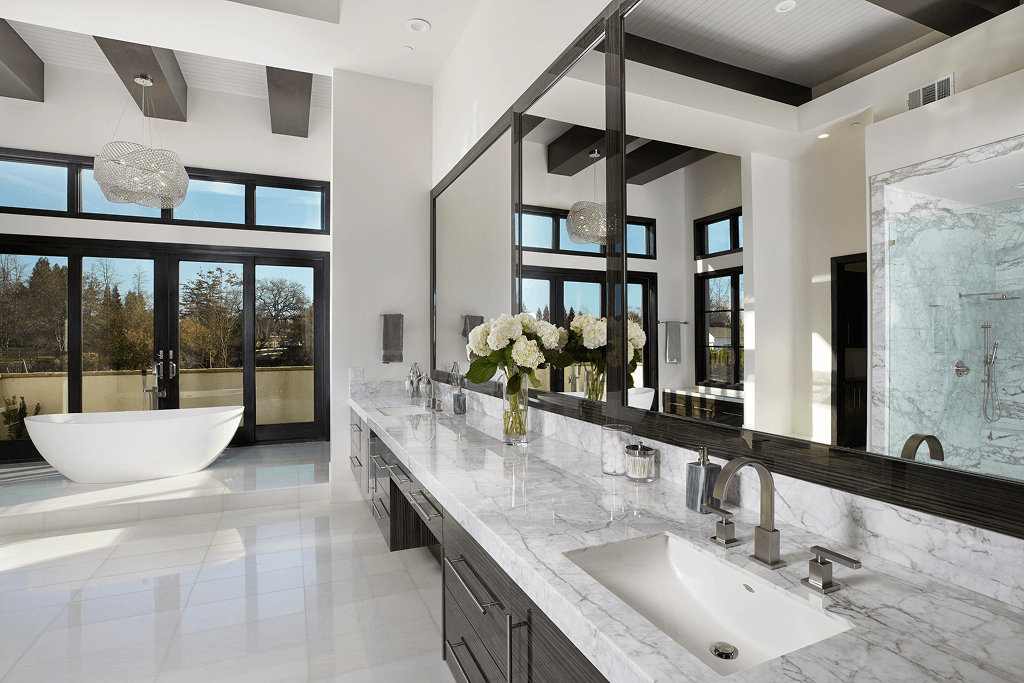
Bathroom Tile Layout
No two bathrooms are alike, which is exactly what makes bathroom tile design so exciting! Tile layouts for bathrooms can be tailored to the size of the room, the way it’s used, and the mood you want to create.
In a primary bath, for example, a continuous floor-to-wall look may create a spa-inspired calm, while a half bath might benefit from a bold backsplash that becomes the focal point. By matching the layout to the purpose of your bathroom, you get a space that looks beautiful and functions seamlessly.
Primary Bathroom Tile
The primary bathroom is often the showpiece of a home. Flooring and shower walls are obvious candidates for tile, but backsplashes, vanities, and even accent walls can all make a statement.
When brainstorming primary bathroom tile ideas, consider pairing a durable porcelain floor with a marble or quartz feature wall, or use contrasting finishes to set apart the shower area from the rest of the space.
Half Bathroom (Powder Room)
What is a half bathroom? Sometimes called a powder room, this compact space usually includes just a sink and a toilet. That limited footprint means every design choice makes an impact.
Flooring and backsplash areas are perfect opportunities for creativity. Powder room tile ideas often lean bold, such as a dramatic mosaic behind the sink or a high-gloss finish that reflects light. For half bathroom design ideas that truly impress guests, choose patterns or textures that feel luxurious, even in a small space.
Large Bathroom
Large bathrooms provide a canvas for more expansive tile design. Flooring can be extended with large-format porcelain for a sleek, modern look, while shower walls can be differentiated with a contrasting natural stone. Built-in shower benches and backsplashes also become design opportunities.
Large bathroom tile ideas often emphasize flow, so repeating materials across multiple surfaces helps the room feel cohesive rather than overwhelming or disjointed.
Wet Room
A wet room is an open-style bathroom where the shower isn’t confined to a stall, but is integrated with the rest of the space. This layout makes the bathroom feel larger and more luxurious, but it can also improve accessibility by removing barriers like thresholds. Wet room tile design should balance both style and practicality, since water reaches more surfaces.
Wet room tile ideas include using textured flooring with R11 finishes for slip-resistance, while contrasting stone on the shower wall can add a visual break. You can either embrace a seamless, spa-like look by carrying one material throughout or create distinct “zones” with different finishes.
Small Bathroom
In a compact space, every inch counts. Tile ideas for small bathrooms often focus on maximizing light and creating visual openness. Glossy finishes can reflect light and make the room feel larger, while vertical patterns on walls add height.
Flooring also plays an important role in the overall design. A continuous floor surface with minimal grout lines can create the illusion of more square footage. Small bathrooms benefit from strategic accents too, such as an alcove lined with a contrasting mosaic.
Guest Bathroom
A guest bathroom should be warm, welcoming, and easy to maintain. Since it often serves occasional visitors, this is a great space to play with personality. Guest bathroom tile ideas can include a striking backsplash behind the vanity or a textured accent wall.
Durable materials like porcelain work well on flooring and shower walls, while a marble countertop or quartz feature adds elegance. With guest bathroom tile, the goal is to balance comfort with a touch of “wow.”
Public Bathrooms
Public bathrooms, such as those in restaurants, hotels, or retail spaces, should be designed to prioritize easy-to-clean surfaces, slip-resistant flooring, and layouts that accommodate accessibility. In general, public bathroom tile ideas often lean on large-format options that reduce grout lines and make cleaning easier.
But that doesn’t mean these spaces can’t be stylish! Restaurant bathroom design ideas, for example, can use tile that echoes the dining room’s aesthetic—whether modern, rustic, or upscale—to create a cohesive guest experience.
Accessible Bathrooms (ADA)
An ADA accessible bathroom is designed with safety, mobility, and comfort in mind. Wider doorways, lower counters, and barrier-free showers are key elements. ADA bathroom tile ideas focus on slip-resistant flooring such as tiles with R11 finish and materials that transition smoothly between wet and dry areas.
For showers, no-threshold entries paired with large-format porcelain or natural stone keep the look sleek while meeting safety standards. Thoughtful design ensures an accessible bathroom feels just as stylish as it is functional.
Best Bathroom Tile Material for Your Project
Once you’ve mapped out your bathroom’s layout and function, the next step is choosing the right material. Each option below brings its own personality, performance, and required level of care.
Porcelain
Porcelain bathroom tile is one of the most popular choices for good reason. It’s durable, water-resistant, and available in a wide variety of finishes and colors. Thanks to its low maintenance needs, porcelain works beautifully for flooring, walls, showers, and backsplashes. Porcelain’s versatility makes it a reliable foundation for nearly any design.
Ceramic
Ceramic bathroom tile shares some similarities with porcelain, but it’s more porous and has a higher water absorption rate. For these reasons, we don’t recommend it for floors. However, it shines on bathroom walls, vanity backsplashes, or other vertical surfaces.
Ceramic’s wide range of colors and finishes makes it a great choice when you’re seeking a specific tone or texture in your design.
Marble
Marble bathroom tile has been used for centuries to convey elegance and luxury. In modern bathrooms, it often takes center stage as a countertop, shower wall, or accent feature. The natural veining patterns bring artistry to the space.
Marble does require sealing and more attentive care than other materials, but for many homeowners, its timeless appeal is worth the extra effort.
Quartz
Quartz is known for its balance of beauty and practicality. It’s highly versatile, being a great choice for bathroom countertops, walls, or shower surrounds. Depending on your style, quartz bathroom designs can lean soft and understated or bold and eye-catching.
Since it’s engineered, quartz is non-porous and relatively low-maintenance compared to natural stone, making it a favorite for busy households.
Granite
Granite bathroom designs highlight this natural stone’s durability and long-lasting appeal. Granite shines as a countertop, shower wall, or even a statement vanity surround. Its varied patterns and wide range of colors offer both visual interest and resilience.
Like other natural stones, granite does benefit from regular sealing to protect against moisture.
Quartzite
Quartzite is another natural stone that’s gorgeous and strong. Because of its hardness and durability, it’s best suited to be used as slabs rather than smaller cut pieces. This makes it ideal for shower walls, countertops, or dramatic feature walls.
Quartzite bathroom designs highlight the stone’s unique veining and luminous finish, adding a touch of luxury to any space. While harder than marble, it still requires sealing to maintain durability and protect against water absorption.
Limestone & Travertine
Limestone and travertine bring an earthy warmth to bathroom spaces, but each has its own character. While all travertine is a form of limestone known for its natural pits and textural surface, not all limestone is travertine. Traditional limestone typically offers a smoother, more understated look than travertine.
In bathroom design, limestone works beautifully in serene, spa-like spaces, while travertine lends itself to rustic or Mediterranean-inspired settings. Though less common than porcelain or marble, both stones can create distinctive, authentic looks. They do require regular sealing and maintenance, but for those who value natural charm, they’re a rewarding choice.
Natural Stone
Natural stone bathroom tile, whether marble, quartzite, limestone, or granite, offers unmatched uniqueness since no two pieces are alike. Compared to manufactured surfaces, it carries a sense of timeless authenticity. The trade-off is maintenance, as sealing and careful cleaning are often required.
Glass Tile
Glass bathroom tile is best used as an accent, bringing shimmer and depth to a design. Often seen in backsplashes, shower niche details, or decorative bands, glass reflects light beautifully and adds a contemporary touch. It’s also relatively easy to maintain, needing only regular wiping to keep its shine!
Bathroom Tile Types
Bathroom tile design goes beyond just picking the right material. It also involves thinking about where and how you’ll use it. Exploring the types of bathroom tile available for each area helps you create a cohesive design that’s both functional and beautiful.
Bathroom Tile Flooring
Bathroom floor tile is the foundation of the room, setting the stage for the entire design. Since flooring needs to handle constant moisture and foot traffic, durability and slip-resistance are key.
Bathroom floor tile ideas range from sleek porcelain in large formats for a modern look to natural stone that brings warmth and character. Grout color also makes a big impact; a grout color that is complimentary to the tile color creates a cohesive, consistent appearance whereas a grout color that contrasts the tile color adds definition and highlights unique shapes.
Bathroom Wall Tile
Bathroom wall tile needs to stand up against constant moisture. Choosing materials like porcelain or ceramic will help your walls stay resilient and will be easier to clean—even with daily splashes and steam.
Bathroom Vanity Backsplash Tile
A bathroom backsplash is a natural place to make a design statement. Positioned behind the vanity or sink, bathroom vanity backsplash tile can complement your countertop or introduce its own unique personality. Classic subway shapes, shimmering glass, or bold mosaics are all options to bring dimension and interest to this small but impactful feature.
Bathroom Shower Tile
Showers are one of the most exciting places to experiment with bathroom tile. From floors and accent walls to benches and niches, every surface presents a design opportunity. Bathroom shower tile ideas include creating a seamless spa-inspired look with one material throughout, to mixing patterns and textures for contrast.
For steam showers, it’s important to choose materials that withstand higher humidity and temperature changes (porcelain and properly sealed stone are both options).
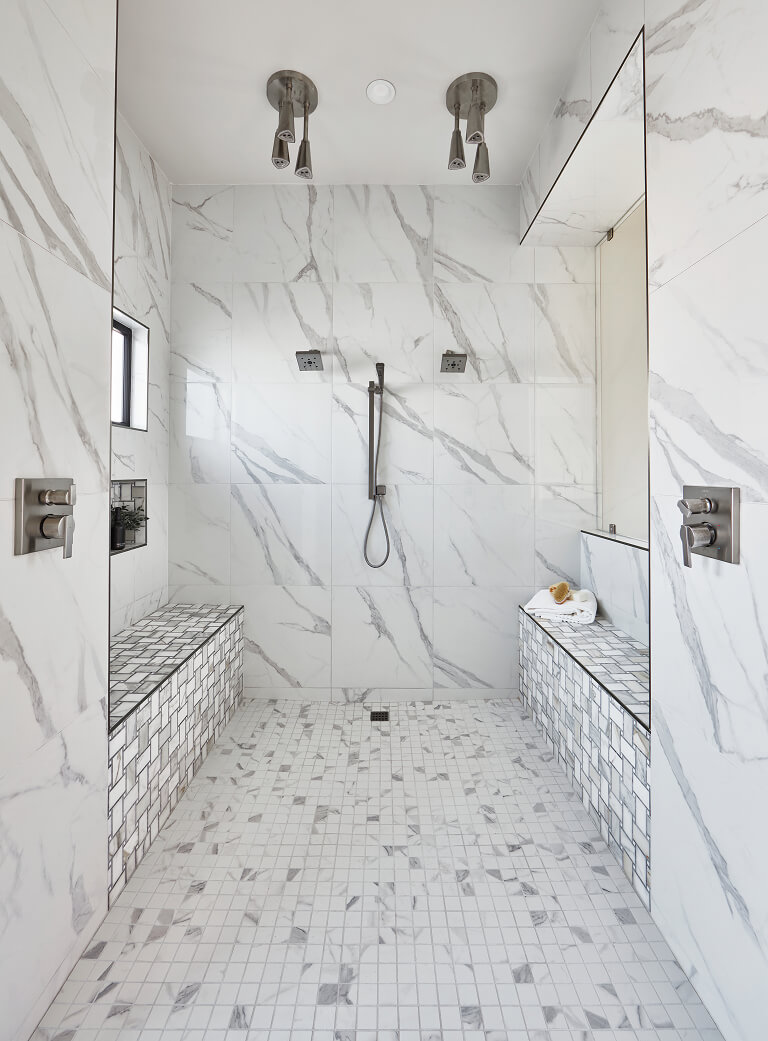
Bathroom Tile Shapes
Bathroom tile doesn’t always need to be square. Playing with different shapes can bring energy, movement, and personality to your design. Experimenting with bathroom tile shapes can turn even the smallest surface into a standout feature.
Subway Tile
Bathroom subway tile is a classic choice that never goes out of style. Its clean, rectangular shape works beautifully for walls, backsplashes, or even as part of a shower surround. Depending on how you lay it out—stacked, offset, or in a herringbone pattern—bathroom subway tile can look traditional, modern, or somewhere in between.
Small Mosaic Tile
Small mosaic tile adds intricate detail and texture, making it a favorite for accent walls, shower niches, or bathroom floors. When used as floor tile, it helps with slip-resistance since the extra grout lines add traction.
Hexagon and Picket Tile
Hexagon tile and picket tile deliver striking geometric patterns that add dimension and interest. Hexagons can be used on floors for a playful nod to vintage design or on walls for a modern statement. Picket tile, with its elongated diamond-like shape, brings a sleek, contemporary edge to backsplashes and shower walls. Both options create surfaces that double as art.
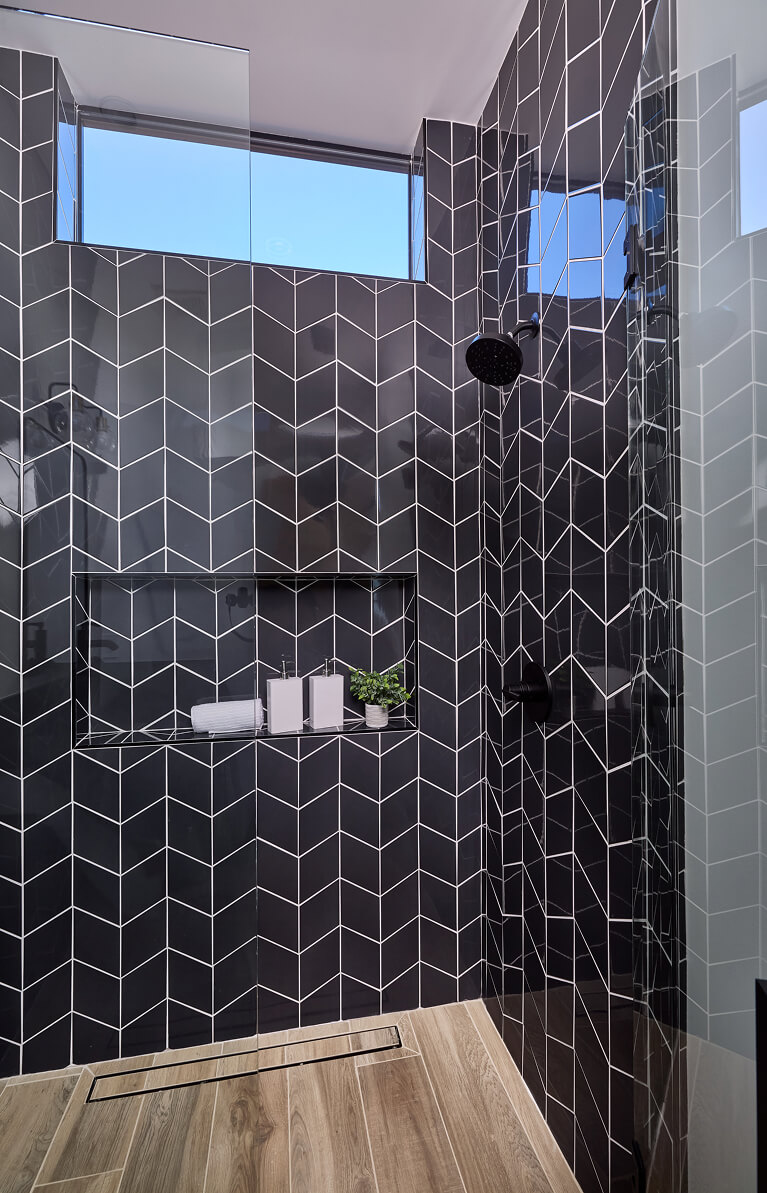
Bathroom Tile Patterns
How you arrange tile can completely transform the look of a bathroom. Beyond the shape and material you choose, patterned bathroom tile layouts add character and flow, helping you customize your bathroom to match your unique design vision.
Herringbone Bathroom Tile
Herringbone bathroom tile is created by laying rectangular tile in a zig-zag pattern, adding instant movement and energy. It’s popular for flooring, backsplashes, and accent walls, where the pattern can serve as a focal point.
Basketweave Bathroom Tile
Basketweave bathroom tile mimics the look of interwoven strands, offering texture and dimension. It’s a timeless option often used on bathroom floors or shower walls, but it also works well as a backsplash. This pattern pairs especially well with stone or marble, where the natural veining adds depth to the weave.
Vertical and Diagonal Stack
Stacked layouts offer a clean, contemporary feel. A vertically stacked tile bathroom design emphasizes height, making the room feel taller, while diagonal or horizontal stacked tile bathroom layouts create a sleek, linear aesthetic. These styles are ideal for modern bathroom spaces that highlight order and symmetry.
Offset Tile
Offset tile layouts are among the most common, where each tile is staggered from the row above. A 50% offset is traditional, but a 33% offset can be used for a more subtle shift. Offset layouts are especially popular with subway tile, where the stagger creates a familiar, timeless look.
Checkerboard Tile
A checkerboard pattern uses contrasting colors to create a bold, graphic statement. In bathrooms, it works especially well on floors, where the alternating squares add drama and personality. Depending on the color scheme, tile installed in a checkerboard pattern can feel classic and vintage or daring and modern.
Diamond Tile
Diamond tile layouts bring a geometric twist to traditional square tile by rotating it on the diagonal. This creates a sense of movement and visual interest, perfect for accent walls, shower walls, or even vanity walls for those who want geometric patterns. TIle installed in a diamond pattern offers a playful yet sophisticated way to make a bathroom feel unique.
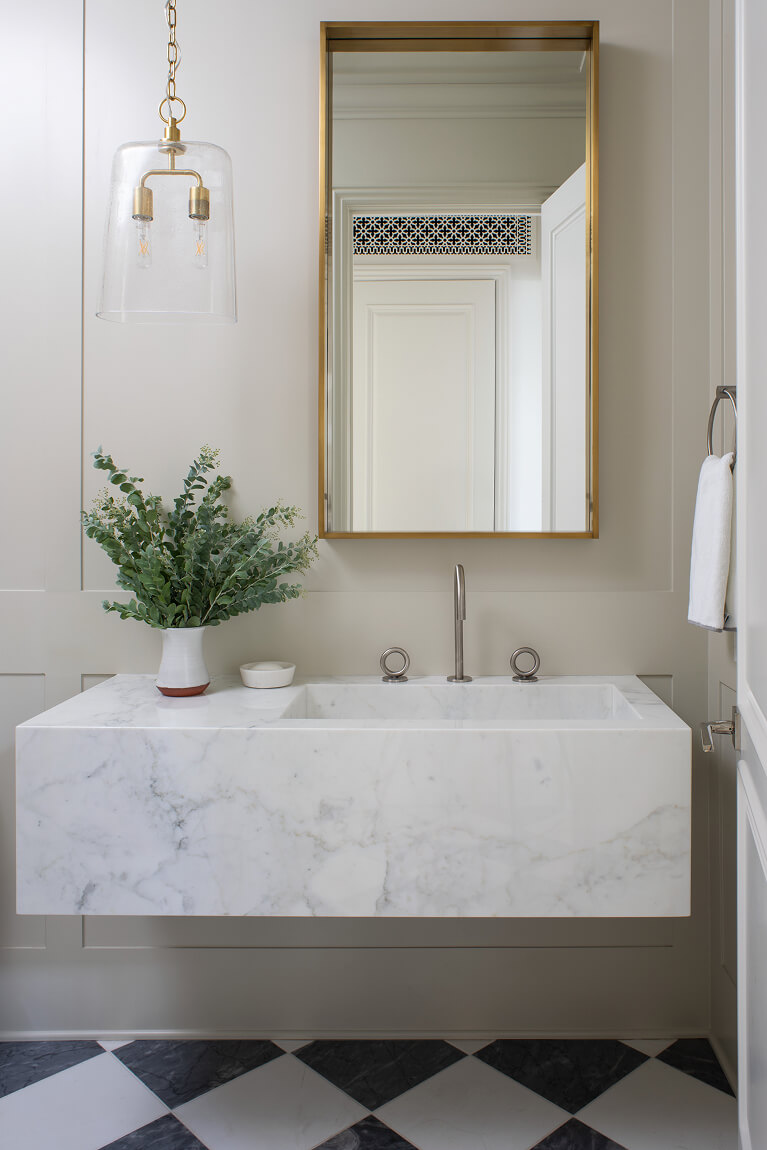
Bathroom Tile Colors & Finishes
Color and finish can dramatically influence the overall tone of a bathroom. From calming neutrals to bold accents, the palette you choose sets the mood, while finishes like matte or glossy determine how light interacts with the space. Exploring bathroom tile colors and bathroom tile finishes is a great way to fine-tune your design.
Neutral Bathroom Tile
Neutral bathroom tile is timeless and versatile, serving as a base that works with nearly any style. Shades of white, cream, beige, and gray create a calm backdrop, allowing other features like fixtures or mirrors to shine. Neutral tones also make a bathroom feel brighter and more spacious, which is especially helpful in smaller rooms.
Bold Bathroom Tile Colors
Bold bathroom tile is the perfect vehicle for making a statement. Deep blues, emerald greens, or even black can turn a backsplash, accent wall, or shower surround into the star of the room. Designers often pair bold bathroom tile colors with lighter, neutral tones to maintain balance while simultaneously showcasing personality.
Bathroom Tile Finishes
Finish plays just as important a role as color. Glossy bathroom tile reflects light, making spaces feel larger and brighter, perfect for smaller or darker bathrooms. Matte finish bathroom tile, on the other hand, provides a soft, understated look with the added benefit of minimizing water spots and fingerprints.
Mixing finishes is another design option that can create depth, such as combining a glossy backsplash with matte floor tile for contrast.
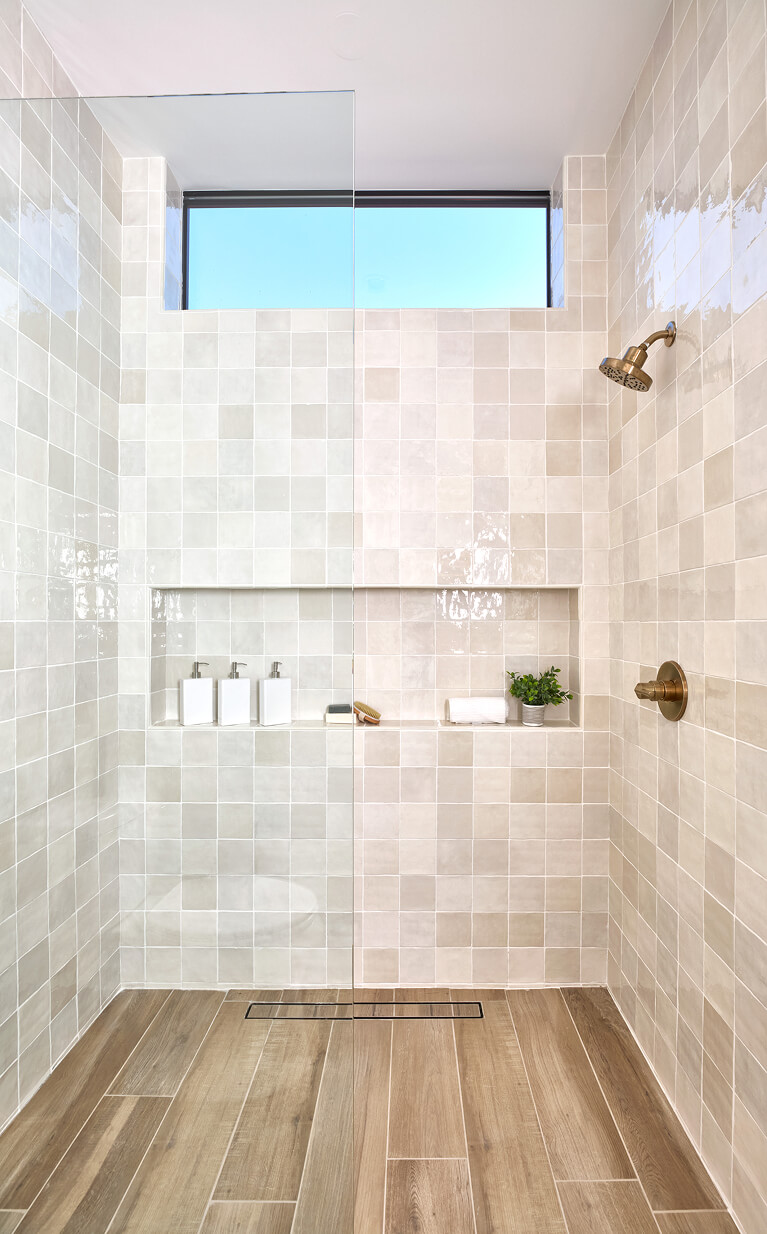
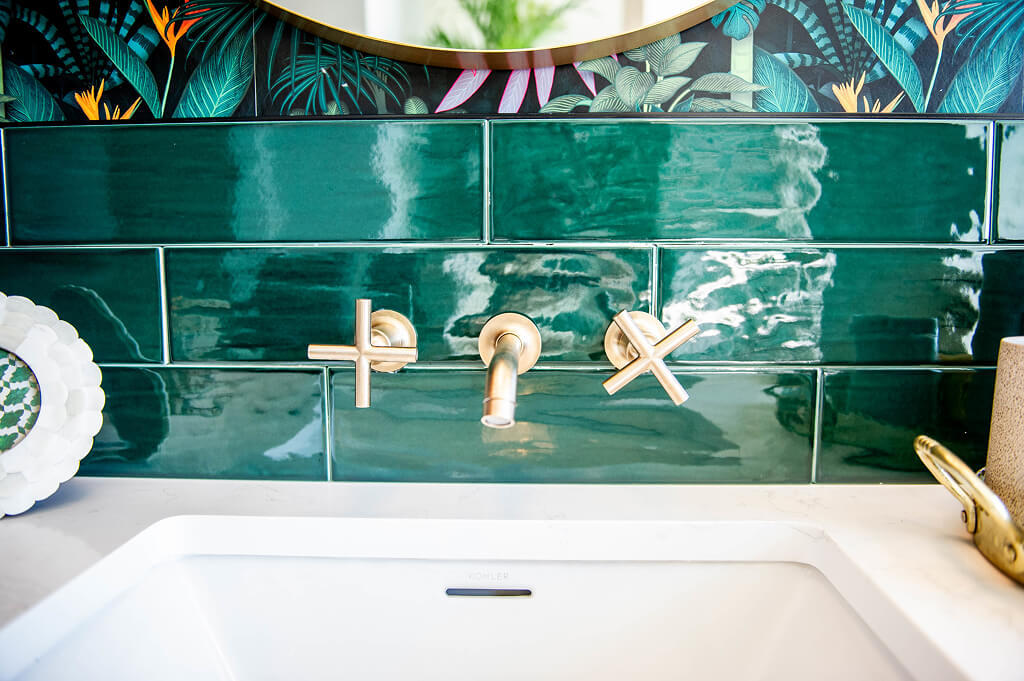
Bathroom Tile Liners, Molding, & Trim
Tile liners, molding, and trim are small but impactful elements that help complete a bathroom design. Liners create subtle separation between surfaces or patterns, molding adds a polished edge to transitions, and trim pieces provide clean borders around niches, countertops, or accent walls. These details help your bathroom feel inviting while protecting edges from chips or damage.
Bathroom Tile Trims
Bathroom tile trim comes in a variety of shapes and styles, including bullnose, quarter-round, and pencil trim. Tile trim can be used to finish the edges of shower walls, backsplashes, or around flooring, giving the installation a seamless, professional look.
Bathroom Tile Grout
Grout fills the spaces between each tile, provides structural support, and helps prevent water from seeping behind surfaces. Bathroom tile grout also influences durability, cleaning requirements, and the overall style of your design, making it an essential consideration in any project.
Types of Bathroom Tile Grout
There are two main types of bathroom tile grout: sanded and unsanded. Each one serves a specific purpose.
Sanded
Sanded tile grout contains fine sand particles, making it ideal for joints wider than 1/8 inch. It’s highly durable and works well for bathroom floors and other high-traffic areas. Sanded grout comes in a variety of colors, giving you the option to select a color that blends seamlessly with your tile or creates contrast. Always consult a professional installer to determine the best choice for your project.
Unsanded
Unsanded tile grout is smooth, free of sand, and good for narrower joints, typically under 1/8 inch. It’s perfect for wall tile applications, backsplashes, and decorative accents. Unsanded grout also comes in a range of colors and should be installed by a professional for a long-lasting, even finish.
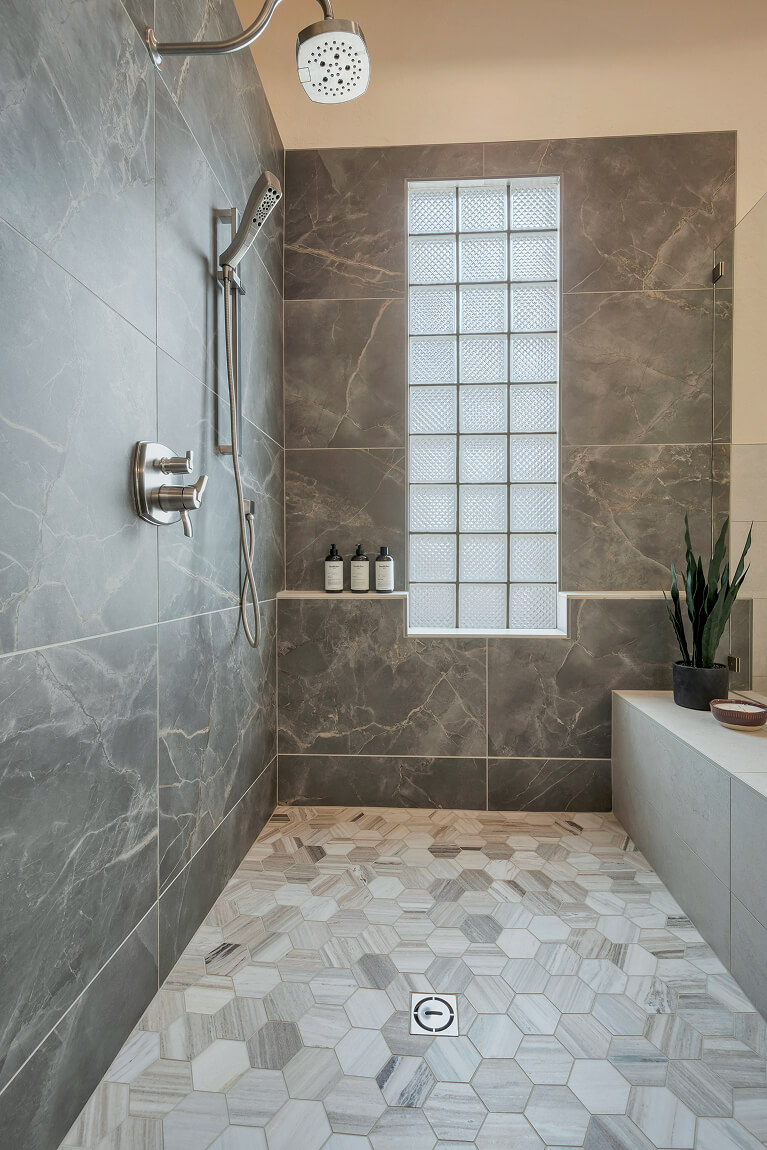
Large-Format Bathroom Tile
Large-format bathroom tile creates a sleek, modern look while minimizing grout lines, which makes it easier to clean and maintain. It works especially well in larger bathrooms, where expansive surfaces can showcase the material’s texture or pattern without feeling overwhelming. That said, with careful planning, large-format tile can also be used creatively in smaller spaces to elongate walls or floors.
Porcelain and natural stone often have the widest selection of large-format options, providing flexibility in color and finish.
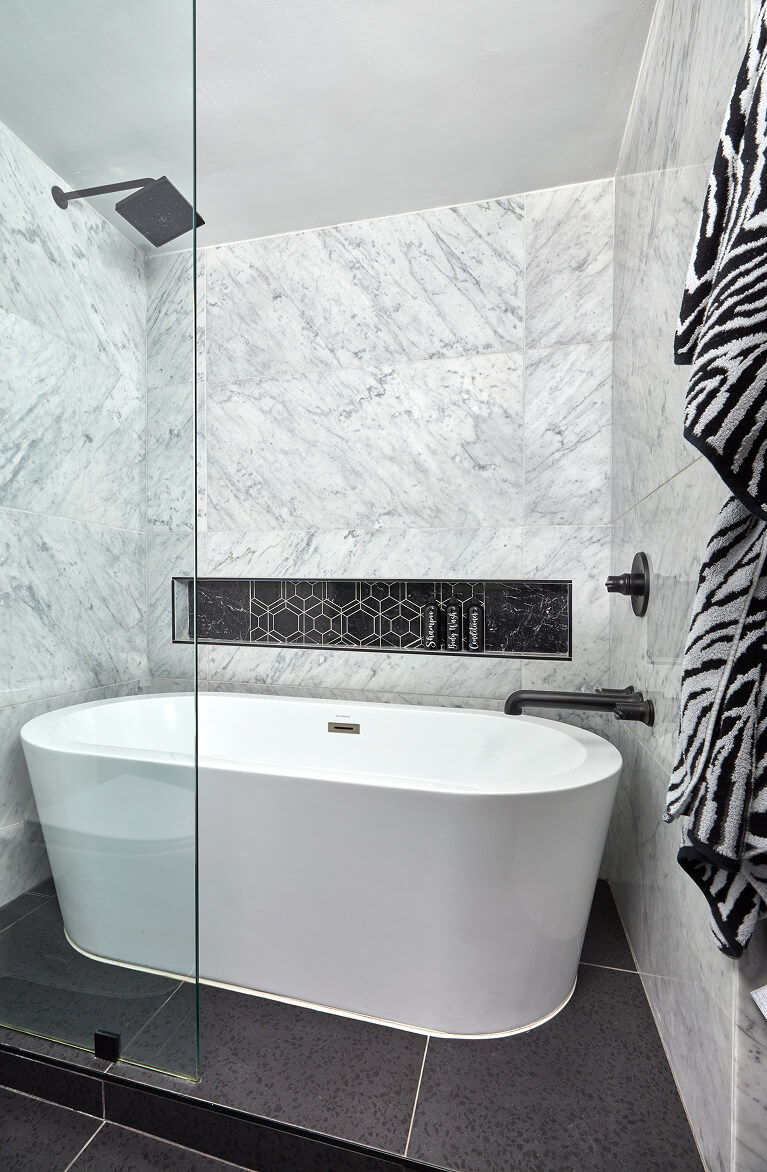
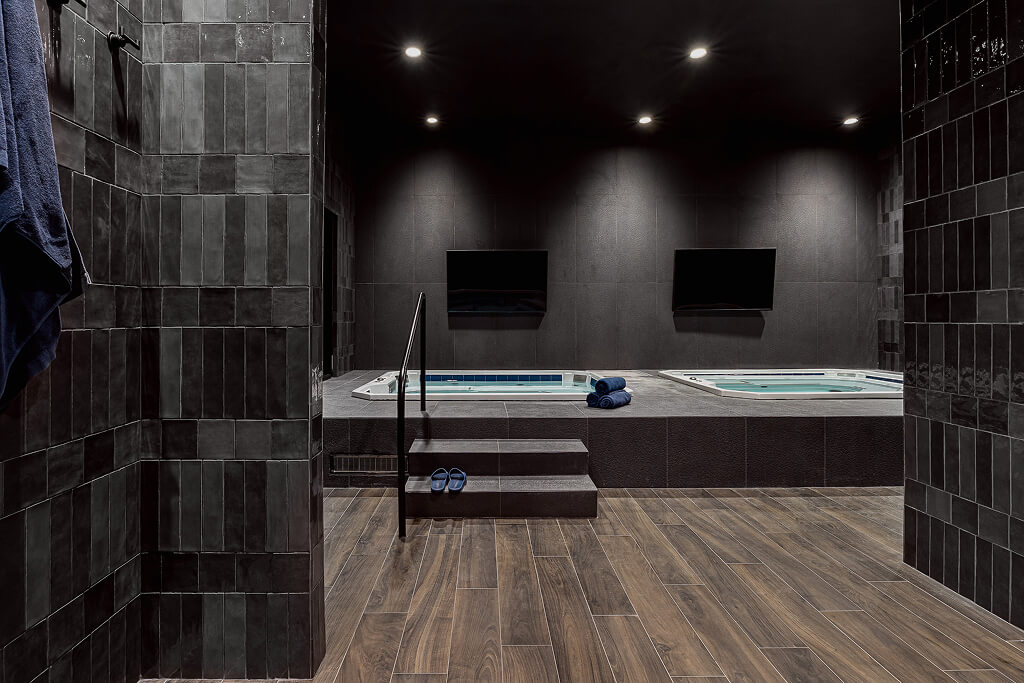
Wood-Look Bathroom Tile
Wood-look bathroom tile combines the warmth and beauty of natural wood with the durability and water resistance of porcelain tile. It’s popular for flooring because it creates a cozy, inviting atmosphere without the worry of warping or water damage.
Wood-look bathroom tile options also work well on accent walls or even shower areas, adding texture and natural appeal while remaining practical for wet areas.
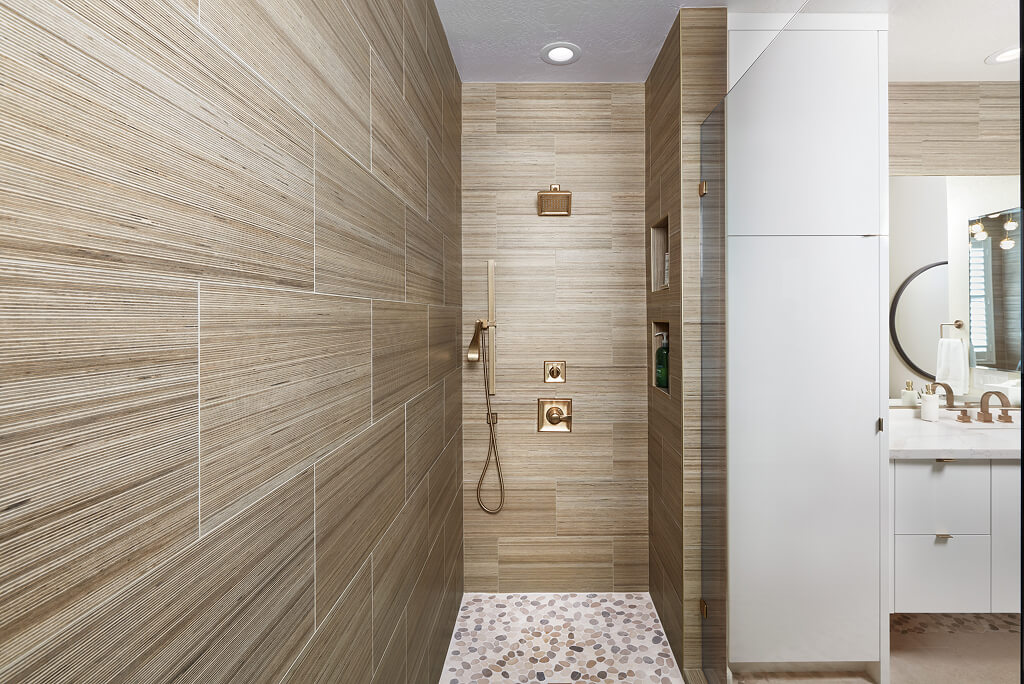
Textured Bathroom Tile
Textured bathroom tile brings depth and dimension to vertical surfaces. Because raised patterns can be harder to clean and may not offer optimal slip resistance, these designs are best reserved for walls rather than floors. On accent walls, shower surrounds, or backsplashes, textured finishes catch light beautifully and create striking focal points that elevate the entire space with a touch of artistry.
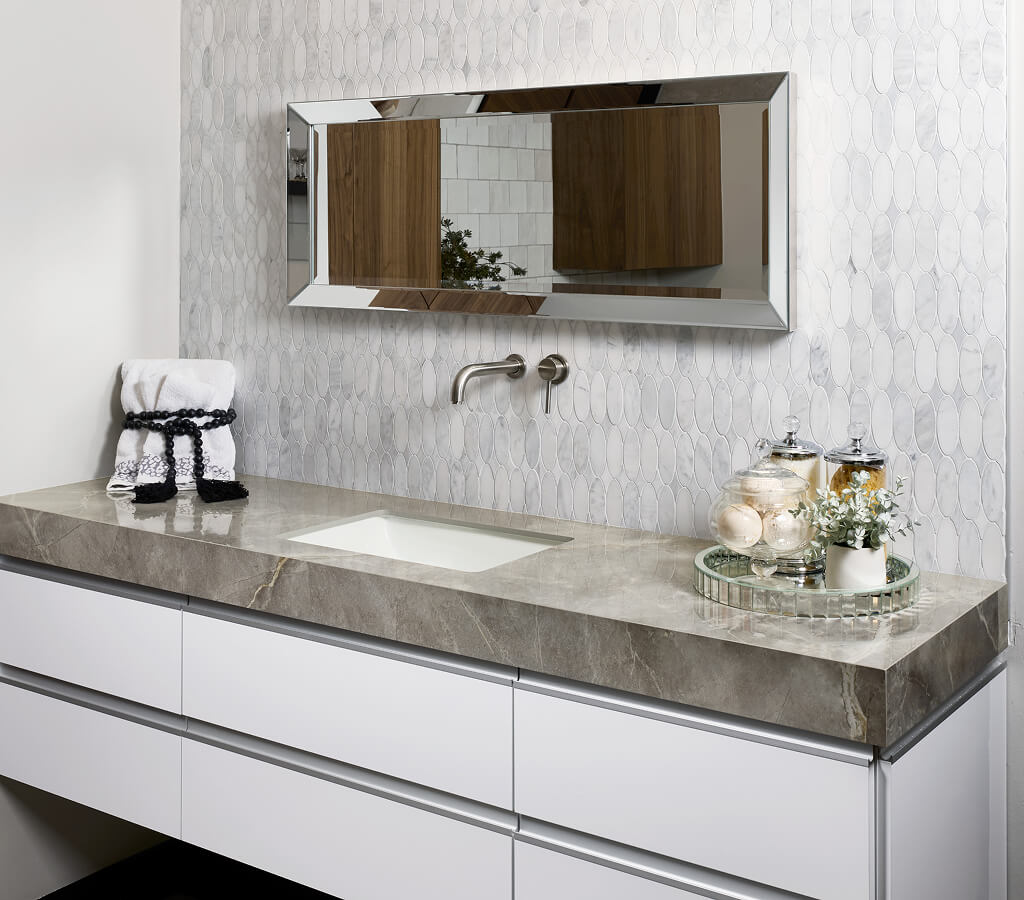
Bathroom Tile Safety Considerations
Safety is a critical factor when selecting tile for wet areas like bathrooms. R11 Finish Tile is designed specifically for environments prone to water exposure, such as shower floors or wet room spaces. The R11 rating comes from the German Ramp Test (DIN 51097), which measures at what incline a person begins to slip when liquids are present. Tile with a R11 finish performs well on inclines between 19° and 27° and is a reliable choice for wet areas.
Arizona Tile also offers an innovation called Active R11 Finish, featured in newer series like Verrazzo and Fluida. Unlike the traditional R11 finish, which uses a mineral coating for texture, Active R11 achieves slip resistance through a special glaze that becomes grippier when wet. This method provides the same level of safety while offering a smoother, more natural feel when dry and, in some cases, makes cleaning easier.
While you may also hear about DCOF (Dynamic Coefficient of Friction) ratings in the U.S., it’s primarily designed for indoor testing and doesn’t directly translate to exterior or wet-rated tile. Both R11 and Active R11 finishes meet the same safety standards, so choosing either depends on your aesthetic and tactile preferences. For bathrooms, we recommend R11-rated tile specifically for shower floors or wet room areas to prioritize safety without compromising design.
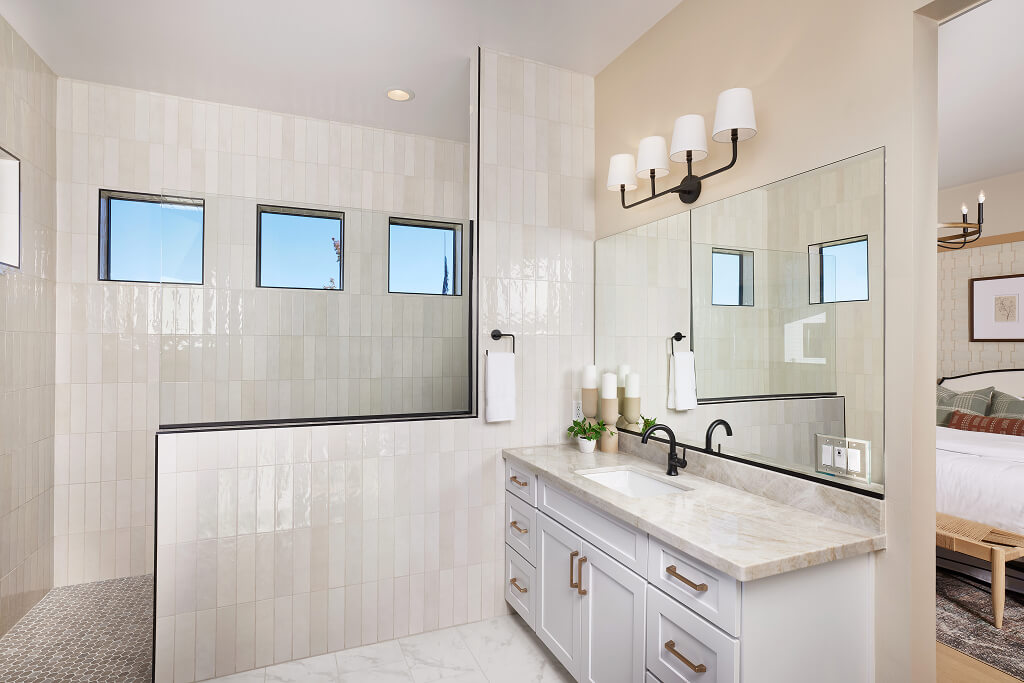
Bathroom Remodel Project Checklist
A successful bathroom remodel starts with organization and a clear plan. Using a bathroom remodel checklist helps you stay on track, make informed decisions, and be certain no detail—big or small—is overlooked during your design process.
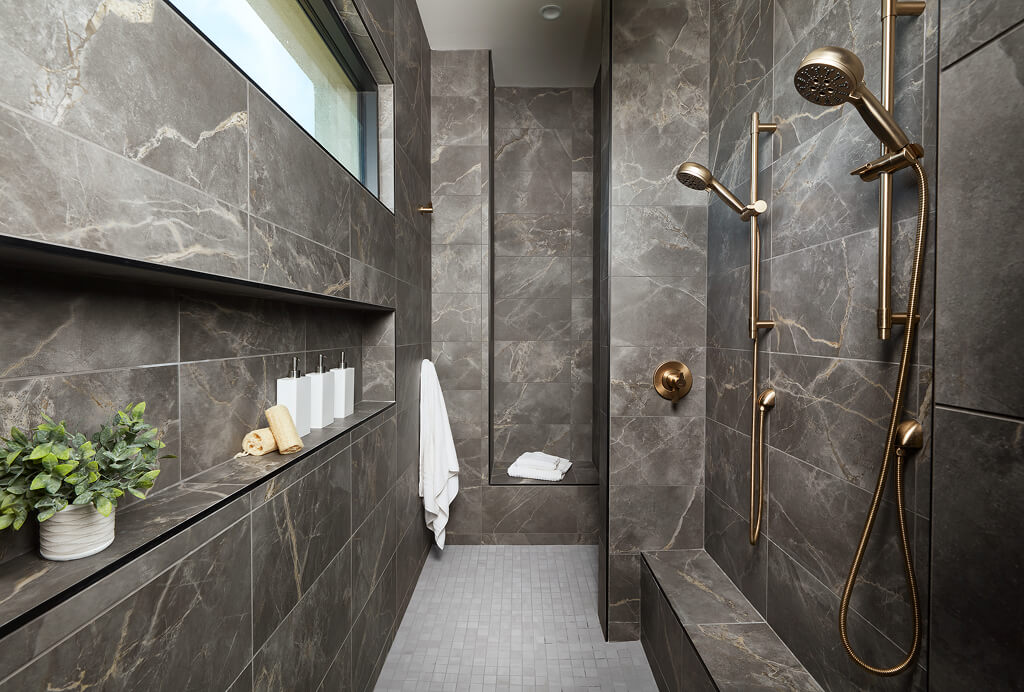
Bathroom Tile FAQs
How Do I Clean Bathroom Tile?
Use a mild, non-abrasive cleaner and a soft cloth or mop to maintain both the tile and grout. For textured or natural stone surfaces, follow manufacturer recommendations to preserve the finish and prevent damage. Regular cleaning helps prevent soap scum, water spots, and grout discoloration.
How Do I Pick Bathroom Tile?
Consider the room’s size, layout, and moisture exposure, then choose materials, colors, shapes, and finishes that balance style and functionality. Durable, water-resistant options like porcelain work well for floors and showers, while ceramic, glass, or natural stone can create decorative accents. Also, think about maintenance needs and the overall design aesthetic you want to achieve.
Is Porcelain Tile Good for Bathroom Floors?
Yes. Porcelain is highly durable, water-resistant, and low-maintenance, so it’s a top option for bathroom floors. It also comes in a wide variety of colors, finishes, and sizes, allowing you to match your floor to the overall design of your space.
Can You Paint Bathroom Tile?
You can, however, it requires proper surface preparation and the right type of paint—typically an epoxy or specialty tile paint. While painting can refresh the look of old tile, it’s generally a temporary solution compared to replacing the tile, as painted surfaces may chip or peel over time. In general, we do not recommend painting over your bathroom tile, and instead select a color, style, and pattern you prefer.
Get Started on Your Bathroom Design
This bathroom tile selection guide has shown that choosing the right bathroom tile is about so much more than style alone. This decision also needs to consider durability, safety, and how to design a space that complements your lifestyle. Check out our gallery for inspiration and explore our full tile selection to discover designs you love.
Ready to start your bathroom tile project? View our locations to find a showroom near you or use our Just Imagine Visualizer to see how different materials and layouts look in your space.
You can also visit the Online Slab Yard to check real-time slab inventory. Have questions or need help bringing your bathroom vision to life? Contact us to connect with one of our team members who will be happy to assist you!
